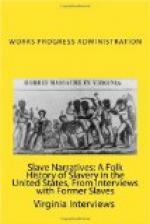“Grandma Katy had Creek Indian blood in her. She was of medium size and height, copper colored, high cheek bones, small squinchy eyes, black curly hair. Her hair was really pretty but she didn’t curl it. It was just naturally curly. She was a practical nurse as they call it, but she did more of what some people call a midwife. They call it something else now. They got a proper word for it.
“They got it in these government agencies. That is what she was even in slavery times. She worked for colored people and white people both. That was after she was freed until she went blind. She went blind three years before she died. She died at the age of exactly one hundred years. She treated women and babies. They said she was a real good doctor in her day. That is been fifty-four years ago. [I will be fifty-four years old tomorrow—September 18, 1938.] In slavery times my grandma was almost as free as she was in freedom because of her work.
“She said that Bob McClendon was cruel to her. Sometimes he’d get angry and take the shovel and throw hot ashes on the slaves. And then he’d see them with blisters on them and he would take a handsaw or a flat plank and bust the blisters. Louisiana was a warm country and they wouldn’t have much clothes on. When the slaves were freed, he went completely broke. He had scarcely a place to live.
“I seen him once. Be look like on old possum. He had a long beard down to his waist and he had long side burns too. Just a little of his face showed. He was tall and stooping and he wore his hair long and uncut down on his neck. You know about what he looked like. He had on blue jeans pants and brogan shoes and a common shirt—a work shirt. He wore very common clothes. When they freed the Negroes, it broke him up completely. He had been called a ‘big-to-do’ in his life but he wasn’t nothing then. He owned Grandma Katy.
“Grandma Katy had a sister named Maria and a brother named Peter. He owned all three of them. I have seen all of them. Grandma Katy was the oldest. She and Uncle Peter stayed close together. He didn’t have no wife and she didn’t have no husband. But Aunt Maria had a husband. She lived off from them after freedom. It was about twelve miles away. My great-aunt and great-uncle—they were Maria and Peter—that was what they were. Uncle Peter died first before I left Louisiana, but Aunt Maria and Grandma Katy died after I came to Arkansas. Grandma Katy lived four years after I came here.
“After they was free and my father had gotten large enough to work and didn’t have no horse, my grandma was going ’round waiting on women—that is all she did—all the rest of the people had gotten large and left home. Papa made a crop with a hoe. He made three bales of cotton and about twelve loads of corn with that hoe. He used to tell me, ’You don’t know nothin’ ‘bout work. You oughter see how I had to work.’ After that he bought him a horse. Money was scarce then and it took something to buy the place and the horse both. They were turned loose from slavery without anything. Hardly had a surname—just Katy, Maria, and Peter.




